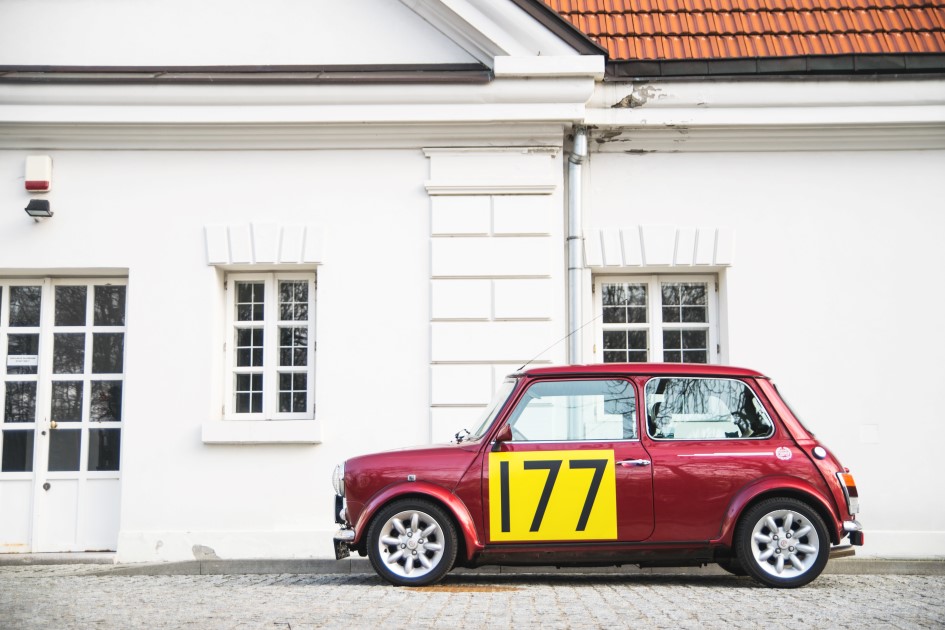[av_image src=’https://www.ardorauctions.pl/wp-content/uploads/2016/11/001_pasek-1500×430.jpg’ attachment=’3157′ attachment_size=’featured’ align=’center’ styling=” hover=” link=” target=” caption=” font_size=” appearance=” overlay_opacity=’0.4′ overlay_color=’#000000′ overlay_text_color=’#ffffff’ animation=’no-animation’][/av_image]
[av_two_third first min_height=” vertical_alignment=” space=” custom_margin=” margin=’0px’ padding=’0px’ border=” border_color=” radius=’0px’ background_color=” src=” background_position=’top left’ background_repeat=’no-repeat’ animation=”]
[av_textblock size=” font_color=” color=”]
Rover Mini 1300 1997
- The last, most refined version of British motoring icon
- Desirable specification
- Incredibly low mileage of 33 000 km
Estimate: 50 000 – 65 000 PLN
Starting price: 30 000 PLN
Chassis number: SAXXNNAZRWD150949
Technical Specification:
Engine: 1.3-litre, straight 4
Power output: 70 break horsepower
Other: manual gearbox, front-wheel drive
Legal condition: registered in Poland
Model History
From the very beginning of its production, Mini was an unquestionable motoring icon. This little car helped many Britons squeeze through the narrow streets of congested London. Every onlooker could enjoy its charming looks whenever it drove by. The Mini came second in an international poll to pick the “Car of the 20th Century”, being beaten only by the Ford model T. The reason why the Mini was created was the oil crisis posing a threat to post-war Europe. Development began in 1956 as a response to the works of other European manufacturers who came up with small and fuel-efficient vehicles. Main design principle of the British “People’s Car” were its dimensions of 10 x 4 x 4 feet (3 x 1.2 x 1.2 metres). Engineers were forced to use an existing engine as a cost-saving measure. Project ADO15 (internal designation of the preproduction model) was powered by a four-cylinder, water-cooled BMC engine. It was mounted in the front and transferred its power to the front wheels via a four-speed gearbox. Press launch took place in April 1959. By the second half of the year, first batch of cars for sale was ready. The car was available under Austin or Morris brand – both of which belonged to the BMC consortium. In the 80s and 90s the spirit of Mini was still alive. The car once again became an icon, only this time its popularity lied in its retro style. Limited editions gained a cult following, including Mini 25, Mini Red Flame, Mini Red Hot, Mini Check Mate, Mini Studio 2, Mini Piccadilly or Mini Tahiti. Over the years the Mini was updated seven times, making it difficult to describe each update in detail. The last version called VII was launched in 1996. The main change compared to its predecessors was the use of a 1275 cc engine with twin fuel injections and a front-mounted radiator. Some versions also featured airbags (mandatory according to European safety norms). In 2000 Mini officially went out of production after 41 years. It became an inherent part of London’s urban landscape, but was also loved in Europe. Legendary rally “Cooper S” versions are fetching higher and higher prices on auctions, but more common models are also sought after by collectors. Without doubt, every version of this little city car with a huge heart brings a smile to faces of people passing by.
Vehicle History
This dark red Mini left the factory in 1997 as one of the examples from the last series of this model. The car has been preserved in an immaculate condition. Very low mileage of only 33 thousand kilometres is visible in every aspect of the vehicle. The paint, despite a few distinct scratches, still looks very good. The interior shows no signs of wear and tear, both the wood and the leather upholstery still look very fresh. Thanks to original wide wheels the car looks very muscular. The owner has had several modifications done to the car, making it hugely enjoyable to drive. To improve handling, stock shock absorbers were replaced by custom ones made by Koni, which makes the car incredibly sure-footed on the road. Today’s Minis are advertised as cars providing “go-kart-like driving fun” and this cliché slogan remains absolutely true in case of this car as well. Apart from the suspension, modifications included also a sport exhaust and a short shifter for the gearbox. On the outside, the Mini was fitted with a number of stickers, making it similar to the rally car bearing the 177 number, which won the 1967 Monte Carlo rally. A 20-year car with a mileage of just 33 thousand kilometres is an incredibly rare thing, especially when we talk about such a cult vehicle as the original Mini. It’s a perfect companion for weekend trips and a car with which you can attend various car meets or tourist rallies.
[/av_textblock]
[/av_two_third][av_one_third min_height=” vertical_alignment=” space=” custom_margin=” margin=’0px’ padding=’0px’ border=” border_color=” radius=’0px’ background_color=” src=” background_position=’top left’ background_repeat=’no-repeat’ animation=”]
[av_gallery ids=’3143,3144,3145,3146,3147,3148′ style=’thumbnails’ preview_size=’portfolio’ crop_big_preview_thumbnail=’avia-gallery-big-crop-thumb’ thumb_size=’portfolio’ columns=’1′ imagelink=’lightbox’ lazyload=’deactivate_avia_lazyload’]
[/av_one_third]
[av_gallery ids=’3149,3150,3151,3152,3153,3154′ style=’thumbnails’ preview_size=’portfolio’ crop_big_preview_thumbnail=’avia-gallery-big-crop-thumb’ thumb_size=’portfolio’ columns=’3′ imagelink=’lightbox’ lazyload=’deactivate_avia_lazyload’]

